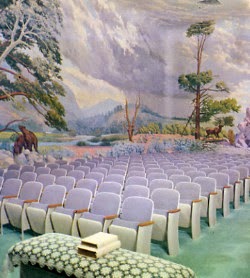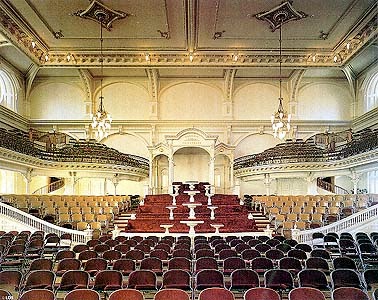Yes, it is actually called the Salt Lake Temple. The others are all called lame things like the Sacramento, California Temple or the Curitiba, Brazil Temple. To be fair, that’s for practicality’s sake. There never was a special naming convention for the temples (with the exception of the planned temples for the City of Zion that was never built) other than the inscription they bear—“The House of the Lord.” My understanding is that that is their name and that the rest of the naming convention is just to specify which of the Houses of the Lord this particular one is, and what easier way than by its location? So the system of naming them on their city or country—the Logan Temple or the Swiss Temple—became less practical when more and more temples were built, necessitating the name change to specify city, state or city, country. Anyway, for one reason or another, the Salt Lake Temple avoided being renamed to the Salt Lake City, Utah Temple.
 |
| Lovely Fall photo by Lane Stevenson |
In the early 20th century, a would-be blackmailer got access to the temple, probably by bribing the gardener, and secretly took photographs of the interior. He threatened to go public with the images unless the Church payed him a great deal of money, and when that didn’t work, he moved east to set up what he imagined would be a highly successful picture show of the temple interior, billed as some sort of embarrassing exposé of the Mormons.
The Church’s response was actually kind of funny: they commissioned Elder James E Talmage to write a book explaining at length the interior and purpose of the Temple accompanied with higher-quality photographs. Today, this book is available with updated photos (in the Deseret Book editions) or the original (in the Signature Books edition) as The House of the Lord, one of Elder Talmage’s classics. I’ll make use of those original photographs (dating from the 1910s) as well as those released for the 1993 rededication.
Let’s take the tour.
Beginning here, in the main hallway. This is actually located in the basement of the Temple, which is accessed via the annex rather than through the main doors, which are rarely, if ever, opened.
Here, the pioneer craftsmanship is amazing. It reminds me a of a strange but sweet combination of classical and simplified baroque styles—I think Elder Talmage called the interior more “Renaissance” in its architecture. The white is actually, as I recall, a light cream, offset by the gold accents. Some discrepancy between the photos show some changes that have been made over the years, including paint choices and art hung on the walls.
Now, I have never been to the baptistry, but I understand that it is on this landing, so I’ll stop there before we get to the Endowment rooms.
I actually believe that the yellower photograph is from the 1960s, when the annex was dedicated. I believe the current color scheme is as in the former photograph, cream with gold accents. Especially of note to me is the difference in the railing styles—the cream latticework in the first image is how it is today, I think. The more stark stairs and railing in the bottom image pretty well sums up my issue with the “modern” aesthetic in general, which was quite popular during the 1960s (some temples from this era: Provo and Ogden). Beauty for beauty’s sake is worthwhile.
It’s hard to convey the proportions here, but imagine that the guard rail is at about elbow height.
On to the Creation Room.
The walls of all the Endowment rooms are covered in murals that illustrate the room’s purpose and tell the story of human progress from our pre-mortal existence as spirit children of God to mortal beings who are trying to find their way back to Him. This room tells the story of the Creation, which I for the record have always thought of as a glorious millions-upon-millions of years of manipulation of the countless variables of nature until—but I have digressed. Don’t mind my commentary. Enjoy the art. Brigham Young actually sent artists to Paris to study painting so that they might produce the best possible murals for the temple. This photo doesn’t quite show the colors—there are a lot more greens and blues than the unintentional warm filters suggest. Also, these photos do, I think, not the best job in conveying the scope. It looks like someone is standing on a tall ladder. The ceiling is actually rather high, as the size of the seats will show.
This is probably the worst angle for this, the Garden Room, representing the Garden of Eden. I say this because you cannot see the ceiling. Again, the warmer photograph doesn’t show the cooler green of the room, which contrasts sharply with the ceiling, which caves upward into a beautiful glass panel illuminated by warm light, which suggests to me the direct contact with God in the Garden of Eden, direct access to Heaven. Very lovely. This second photograph does show it, but the light it a bit too bright to make out the detailed art glass, and the color is even warmer than in the last. The actual coloring is such that the greens really pop out in contrast to the curtains.
Heading upstairs, we pass a stained glass adaptation of a painting you may be familiar with depicting the expulsion of Adam and Eve from the Garden.
Next stop is the Telestial Room.
Paraphrasing Elder Talmage: In contrast to the Garden Room, the Telestial Room depicts the world in its fallen state, and you can see in the murals trees stripped of leaves and bark, storm clouds, and animals fighting.
Continuing on our journey heavenward, we progress to the Terrestrial Room, representing a higher, sanctified Earth.
 |
| Terrestrial Room, early 20th century |
Here is the Terrestrial Room. As you can see, there have been some pretty major changes from the early to the late 20th centurty, namely the arranging of the drapery at the front of the room. The beveled arches for the windows (giving an idea of how thick the walls are) and the stained glass are especially lovely.
 |
| Detail of one of the windows. |
 |
| Detail of stained glass and woodwork. Remember, that woodwork was done by hand. I understand that this is the only art glass in the Temple that was not done by Tiffany. |
I do love that room. But we are not even close to being finished! Incidentally, from the outside, we are standing at the level of the first set of windows, I believe. Let us move on the the Celestial Room, symbolic of the presence of God.
 |
| The statue of Christ above the doorway is different in that it is the only beardless Christ I have ever seen in statuary. |
 |
| I love (a) the Corinthian columns, which I don’t often see indoors, and (b) the Sealing Room visible through the doorway which doubles as a third mirror. |
 |
| Again from the 1910s. I love that round couch. I haven’t seen one quite like it in person. |
I am the true vine, and my Father is the husbandman. Every branch in me that beareth not fruit he taketh away: and every branch that beareth fruit, he purgeth it, that it may bring forth more fruit. Now ye are clean through the word which I have spoken unto you. Abide in me, and I in you. As the branch cannot bear fruit of itself, except it abide in the vine; no more can ye, except ye abide in me. I am the vine, ye are the branches: He that abideth in me, and I in him, the same bringeth forth much fruit: for without me ye can do nothing.In the Celestial Rooms of other temples, a similar thought is expressed in symbolic wheat motifs, bringing to mind the parable of the wheat and the tares.
That concludes the Endowment rooms. Through the Celestial Room, however, we can see into two of the oldest Sealing Rooms, used to perform sealings, or marriages that last for eternity.
 |
| The stained glass depicts the Angel Moroni appearing to the boy Joseph Smith. |
 |
| The stained glass, not very clear in this photograph, includes more grapevine imagery and a harp. |
 |
| A newer image of the same room with the stained glass better illuminated. |
 |
| Looking up at the chandelier. Above the mirror to the right and above the doorway, the harp motif is repeated. |
 |
| This is actually a waiting room through the door behind the altar of the sealing room. |
 |
| More views of the waiting room. Notice the stained glass to the right. Look familiar? |
 |
| Another view of the first room. |
 |
| Although I’ve shown this one several times already, I feel this is a slightly higher quality image. |
 |
| This is actually one of the newer sealing rooms in the Temple, located in an annex added along the length of one of the walls. |
 |
| A little more utilitarian than the other areas of the Temple, but still lovely. |
 |
| More hallway |
 |
| This room is where the First Presidency and the Quorom of the Twelve meet. |
 |
| I believe this is where the Presidency of the Seventy meet. |
 |
| I actually do not know which room this is. It may be another meeting room for the Presidencies of the Seventy. |
So, onward.
 |
| This is one landing of the spiral stairwell that ascends the height of the building. I feel I ought to call attention again to the fact that this was all hand-crafted. |
We ascend to the Assembly Hall. It seems (having never been there myself) that you enter in through a door on a landing much like the one above, and find yourself given an option of sitting on the floor level or in the balcony.
We then enter the Assembly Room proper.
This room is arranged much like the Kirtland Temple, with tiered pulpits on either side for the Aaronic and Melchesidec priesthoods (we use the spelling “Melchizedek” these days, but the inscription above the pulpits does read “Melchesidec,” I think). The pulpits, you may notice, mirror the three-tiered towers on either end of the Temple. The towers are meant to represent the two priesthoods and I see their placement one either end of the Temple as an echo of this room.
 |
| Photo by Pamela K. Killian |
And that pretty well concludes the photo tour I had prepared. This is of course one of my favorite temples—not only for the architecture but also because of extensive family history. Many of my ancestors were married here or passed through here at some point. I myself was married here in 2012. It is a good place. And since I am pursuing an Master’s at The University of Utah, it is the temple closest to me physically as well.
































